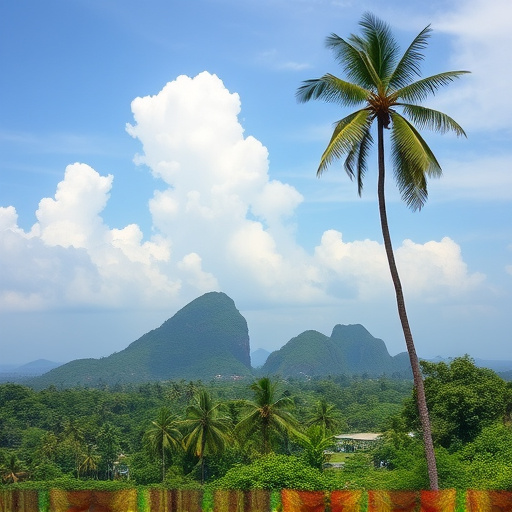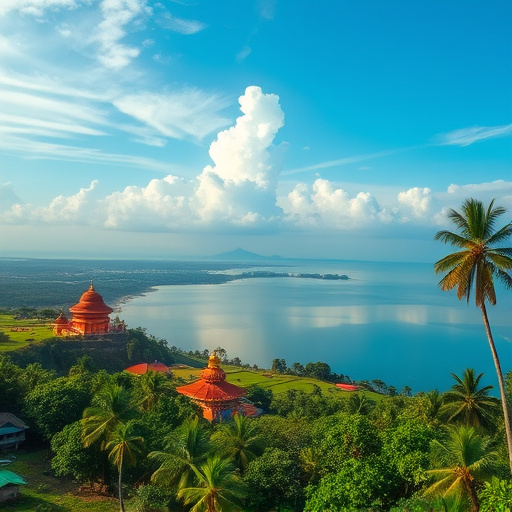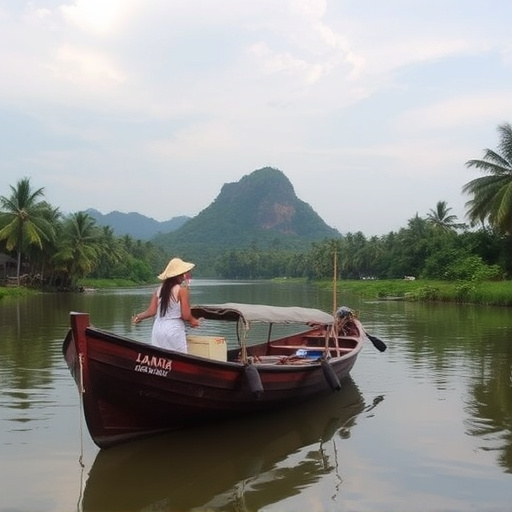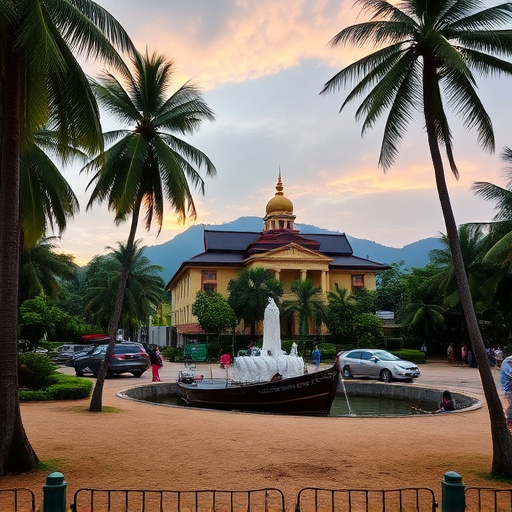The optimal time to visit Sri Lanka for tea pluckings is October to April due to mild temps and reduced rainfall. During this period, engage in cultural activities like hiking plantations and voluntourism. Plan your trip strategically for superior quality tea and immersive experiences, including festivals celebrating the country's rich culture. Consider regional variations in planting seasons (April-September in central highlands, November-March in southern areas) to fully explore Sri Lanka's diverse tea industry.
“Uncover the enchanting world of Sri Lanka’s tea pluckings, a cultural spectacle and sensory delight. The best time to visit aligns perfectly with optimal weather conditions, typically between November and April, offering a unique blend of natural beauty and traditional practices. This article explores the cultural significance of tea pluckings in Sri Lanka, guiding you through the ideal timing for quality leaf selection, regional variations, festive celebrations, and tips for planning an authentic experience amidst the lush green landscapes.”
- Optimal Weather Conditions for Tea Picking Season
- Cultural Significance of Tea Pluckings in Srilanka
- When to Expect the Best Quality Leafy Produce
- Regional Variations in Tea Harvest Times
- Festivals and Events Accompanying Tea Pluckings
- Planning Your Visit for an Authentic Experience
Optimal Weather Conditions for Tea Picking Season

The optimal weather conditions for tea picking in Sri Lanka typically occur during the cooler months, between October and April. During this time, the climate is mild and pleasant, with less rainfall compared to the rest of the year. This makes it an ideal period for tea farmers to pluck the finest leaves, ensuring high-quality teas. The cooler temperatures also mean that the tea bushes are less susceptible to pest and disease issues, further enhancing the overall health and vibrancy of the crops.
For those interested in experiencing Sri Lanka’s tea culture, visiting during this season allows you to engage in various sri lanka adventure activities and tours, including voluntourism opportunities in sri lanka that support local communities. The most popular sri lanka hiking trails also offer breathtaking views of the lush green tea plantations, providing a unique perspective of the country’s famous beverage. So, if you’re planning your trip, consider visiting us at sustainable tourism sri lanka practices anytime between October and April to fully immerse yourself in this picturesque and fragrant experience.
Cultural Significance of Tea Pluckings in Srilanka

In Sri Lanka, tea pluckings hold immense cultural significance, intertwining deeply with the country’s history and economy. This age-old tradition involves the careful harvesting of tea leaves from bustling plantations, a process that is often celebrated as a community event. The rhythm of pluckings sets the pace for rural life, fostering a sense of camaraderie among locals who come together to hand-pick the finest leaves. These rituals not only sustain Sri Lanka’s thriving tea industry but also serve as a vibrant display of traditional practices and cultural pride.
Beyond its economic importance, the art of tea pluckings reflects the island nation’s commitment to sustainability and craftsmanship. As visitors explore Sri Lanka’s lush landscapes, particularly its picturesque tea estates, they gain a deeper understanding of local customs. Engaging in these cultural activities, such as witnessing or even participating in tea pluckings, allows tourists to immerse themselves in authentic experiences that transcend mere travel. Visit us at Sri Lanka cultural norms and etiquette anytime to explore more about these enchanting traditions and their vital role in shaping the country’s vibrant tapestry.
When to Expect the Best Quality Leafy Produce

The best time to visit Sri Lanka’s tea pluckings is during the cooler months, typically from December to April when the weather is pleasant and ideal for outdoor activities. During this period, the tea leaves are at their most vibrant and healthy, resulting in superior quality. The fresh morning air and comfortable temperatures ensure that pluckers can work efficiently, picking only the best leaves.
Planning your visit around these months also allows you to immerse yourself in Sri Lanka’s cultural norms and etiquette while exploring the most popular hiking trails in the country. And for food lovers, this is a perfect time to indulge in Sri Lanka’s diverse culinary offerings as you find us at budget travel tips Sri Lanka, where local cuisine and dining guides are readily available to enhance your experience.
Regional Variations in Tea Harvest Times

The best time to visit Sri Lanka’s tea pluckings varies based on regional weather patterns and the specific tea estate. The central highlands, known for their picturesque landscapes, typically experience optimal conditions between April and September. During this period, the weather is cooler and drier, making it ideal for tea leaf harvesting. In contrast, the southern regions enjoy a more tropical climate, with peak plucking seasons occurring from November to March. These months offer warmer temperatures and lower rainfall, facilitating efficient tea production.
Planning your visit around these harvest times allows you to witness the vibrant process of tea plucking, known locally as “plukking,” and immerse yourself in the rich cultural heritage of Sri Lanka’s tea industry. Moreover, exploring sri lanka visa requirements for us citizens, discovering unique sri lanka art and craft markets, or even taking a whale watching tour in sri lanka at the right time can greatly enhance your overall travel experience. Don’t forget to consider local transportation options when navigating these diverse regions, ensuring a seamless journey throughout your visit.
Festivals and Events Accompanying Tea Pluckings

In Sri Lanka, tea pluckings are more than just an agricultural activity; they’re often accompanied by vibrant festivals and events that highlight the country’s rich culture. The best time to coincide with these celebrations is during the cooler months, typically from October to April, when the weather in Sri Lanka is particularly pleasant. During this period, you can witness local communities coming together to honor their traditions, making your visit even more memorable.
These festivals not only offer a glimpse into the daily lives of Sri Lankans but also provide an excellent opportunity to indulge in the country’s famous sri lanka food and dining guide, explore various sri lanka adventure activities and tours, and find us at planning a trip to sri lanka itinerary. From colorful parades to traditional dances, these events are a delightful mix of local customs and the spirit of camaraderie that makes Sri Lanka so unique.
Planning Your Visit for an Authentic Experience

Planning your visit to align with the tea plucking season in Sri Lanka offers an authentic experience that immerses you in the country’s rich cultural heritage and natural beauty. The best time to witness this ritual is typically between April and September, when the weather is pleasant and the lush green landscapes are at their most vibrant. During these months, you can participate in tea pluckings, learn about the traditional processes, and even hike through some of Sri Lanka’s most popular trails, such as those in Knuckles Mountain Range or Horton Plains National Park.
To enhance your cultural immersion, take a moment to familiarize yourself with local etiquette and norms. Show respect to locals by dressing modestly when visiting religious sites; give us a call at voluntourism opportunities in Sri Lanka for more insights. Additionally, engaging with the communities while enjoying best places to watch sunset in Sri Lanka can provide unforgettable memories. Embrace the warmth of Sri Lankan hospitality, savor the aromatic local cuisine, and immerse yourself in their vibrant festivals for a truly meaningful journey.
Sri Lanka’s tea pluckings, a vibrant cultural spectacle, offer visitors an authentic experience best enjoyed during the optimal weather conditions of October to April. This period aligns with the peak season for high-quality tea leaf production across the country. Planning your visit during regional variations in harvest times allows you to immerse yourself in the cultural significance of these events and participate in associated festivals, making it a truly memorable journey through Sri Lanka’s lush tea landscapes.
